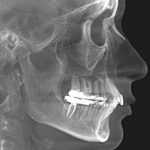Orthodontics and TMJ Therapy for Children, Adults, and Teens
Since so many of my dentist colleagues prefer to not treat TMJ patients, I am now accepting referrals for patients with TMJ complaints in addition to orthodontic cases, (TMJ stands for Temporomandibular Joint, the jaw joint in front of your ears).
I started studying TMJ Disorders in 1979 with Dr. Chuck McNeil at UCSF in what evolved into a 4 year study club. In the mid 1980’s I was invited to join the clinical faculty in the newly formed Craniofacial Pain and TMJ Clinic at UCSF. I was there on Fridays during my General Practice days until I joined my Orthodontic residency in 1987 at UOP in San Francisco. From 1997 to 1999 I studied occlusion and related TMJ issues in orthodontic patients with Dr. Ron Roth in Millbrae. From 2008 to the present I have been studying with Dr. Ron Roncone to augment my understanding of the jaw joints, and in 2016 and 2017 I took Dr. Lou Gallia’s TMD study club course in Sacramento.
TMJ disorders are complex, and many times the patients have associated psychological issues that include stress and anxiety that further complicate treatment.
The most common symptoms associated with TMJ Disorders are:
- Pain in the joints
- Clicking, popping, and locking of the jaw
- Limited range of function
- Muscle pain in the masseters, temporalis, sternocleidomastoid, rhomboid, and trapezius
- Bruxing (grinding and clenching of the teeth)
- Wear on teeth
- Loss of vertical dimension (how deep your bite is)
- Pulpitis (tooth nerve sensitivity to hot and cold)
- Tinnitus (ringing of the ears)
- Headaches
- Tight feeling of the jaws
- Jaw fatigue
They are often also associated with stress, “type A” personalities, depression, and obsessive compulsive disorders.
Researching effective treatment modalities for TMJ Disorders has proven confounding. There so far are no well-done clinical studies that confirm that occlusion is a primary factor. Yet many of us treating TMD patients, including myself, feel strongly that occlusion (how the teeth bite) is a major factor, if not primary, in many of our patients who suffer from TMJ related issues. We feel that way because most of the time our occlusion-based treatment modalities seem to have quite a positive effect in our patients. The contrarians might argue that we are just providing a placebo effect and that any interruption in the patient’s routine is apt to cause at least a temporary improvement. I disagree. Many of these contrarians treat TMJ patients with occlusal splints and physical therapy, which leads me to ask: If occlusion has nothing to do with TMJ disorders, why are you treating your patient with an occlusal orthotic? And getting results???
In our office we do a thorough occlusal exam and TMJ exam that is much more involved than the typical orthodontic exam. For acute patients we will often do some in-office physical therapy and provide a generic soft splint for short-term use only. Full occlusal coverage hard splints with regular occlusal adjustments as the muscles relax are indicated, in most cases with adjunctive physical therapy that includes ultrasound, ethyl chloride sprays, and ice with alternating moist heat. I do not recommend appliances that do not have full occlusal coverage (such as the NTI) as they can lead to over-compression of the joint and orthodontic movement of the teeth.
I like a lab processed flat plane maxillary (upper jaw) acrylic splint, but on occasion will opt for a mandibular (lower jaw) splint when appearance is an issue. Open bite cases are particularly challenging as the splints tend to be rather thick, which is an issue, as for best results the patient should wear the splint 24hrs/day.
Our Treatment usually takes from 4-8 months. We typically achieve very significant reduction in symptoms in just a few weeks. In most cases clicking and popping cannot be completely eliminated but the incidence and intensity is often greatly reduced. After our initial course of treatment we reassess our patients and occlusion to determine if further treatment might be indicated. These might include:
- Orthodontic treatment
- Orthognathic Surgery
- Occlusal Adjustment
- Long term splint wear to protect the joints
If you have any questions about your patients with TMJ problems, please feel free to contact me any time:
My private email is richardportalupi@sbcglobal.net and my cell is (707) 373-2647. You may also call me at the office at (530) 662-9191
Regards,
Richard Portalupi, DDS, MSD
Orthodontic Specialist








